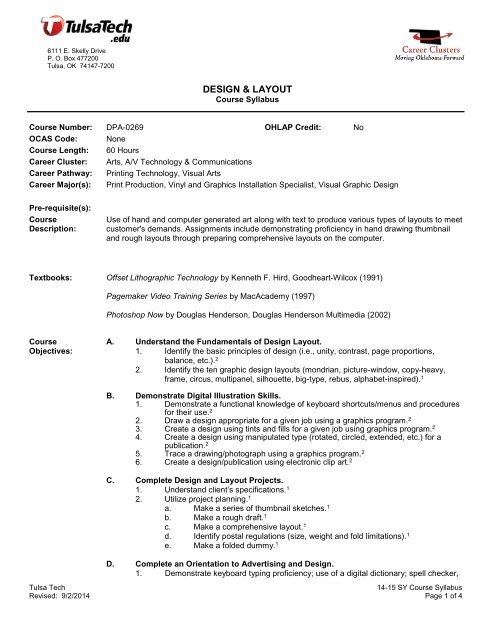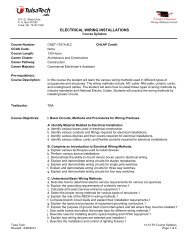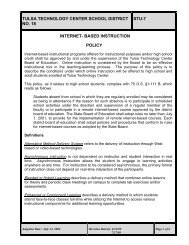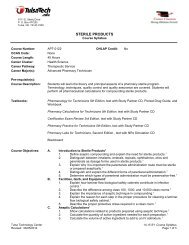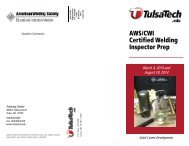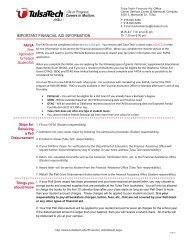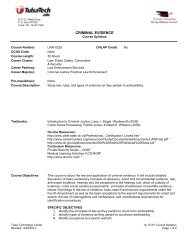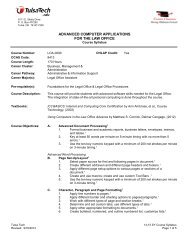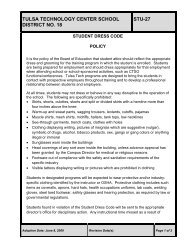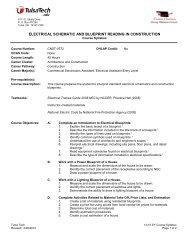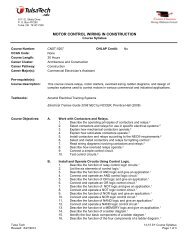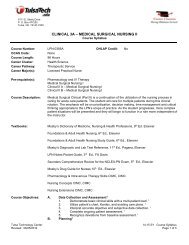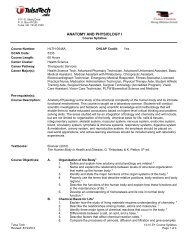Design & Layout - Tulsa Technology Center
Design & Layout - Tulsa Technology Center
Design & Layout - Tulsa Technology Center
Create successful ePaper yourself
Turn your PDF publications into a flip-book with our unique Google optimized e-Paper software.
6111 E. Skelly Drive<br />
P. O. Box 477200<br />
<strong>Tulsa</strong>, OK 74147-7200<br />
DESIGN & LAYOUT<br />
Course Syllabus<br />
Course Number: DPA-0269 OHLAP Credit: No<br />
OCAS Code: None<br />
Course Length: 60 Hours<br />
Career Cluster: Arts, A/V <strong>Technology</strong> & Communications<br />
Career Pathway: Printing <strong>Technology</strong>, Visual Arts<br />
Career Major(s): Print Production, Vinyl and Graphics Installation Specialist, Visual Graphic <strong>Design</strong><br />
Pre-requisite(s):<br />
Course<br />
Description:<br />
Use of hand and computer generated art along with text to produce various types of layouts to meet<br />
customer's demands. Assignments include demonstrating proficiency in hand drawing thumbnail<br />
and rough layouts through preparing comprehensive layouts on the computer.<br />
Textbooks: Offset Lithographic <strong>Technology</strong> by Kenneth F. Hird, Goodheart-Wilcox (1991)<br />
Pagemaker Video Training Series by MacAcademy (1997)<br />
Photoshop Now by Douglas Henderson, Douglas Henderson Multimedia (2002)<br />
Course<br />
Objectives:<br />
A. Understand the Fundamentals of <strong>Design</strong> <strong>Layout</strong>.<br />
1. Identify the basic principles of design (i.e., unity, contrast, page proportions,<br />
balance, etc.). 2<br />
2. Identify the ten graphic design layouts (mondrian, picture-window, copy-heavy,<br />
frame, circus, multipanel, silhouette, big-type, rebus, alphabet-inspired). 1<br />
B. Demonstrate Digital Illustration Skills.<br />
1. Demonstrate a functional knowledge of keyboard shortcuts/menus and procedures<br />
for their use. 2<br />
2. Draw a design appropriate for a given job using a graphics program. 2<br />
3. Create a design using tints and fills for a given job using graphics program. 2<br />
4. Create a design using manipulated type (rotated, circled, extended, etc.) for a<br />
publication. 2<br />
5. Trace a drawing/photograph using a graphics program. 2<br />
6. Create a design/publication using electronic clip art. 2<br />
C. Complete <strong>Design</strong> and <strong>Layout</strong> Projects.<br />
1. Understand client’s specifications. 1<br />
2. Utilize project planning. 1<br />
a. Make a series of thumbnail sketches. 1<br />
b. Make a rough draft. 1<br />
c. Make a comprehensive layout. 1<br />
d. Identify postal regulations (size, weight and fold limitations). 1<br />
e. Make a folded dummy. 1<br />
D. Complete an Orientation to Advertising and <strong>Design</strong>.<br />
1. Demonstrate keyboard typing proficiency; use of a digital dictionary; spell checker,<br />
<strong>Tulsa</strong> Tech<br />
14-15 SY Course Syllabus<br />
Revised: 9/2/2014 Page 1 of 4
DESIGN & LAYOUT<br />
and automatic hyphenation, and keyboard shortcuts. 2<br />
2. Define removable storage media. 2<br />
3. Create an electronic portfolio. 2<br />
4. Demonstrate knowledge of copyright, ethics, and intellectual property rights. 2<br />
E. Understand Type.<br />
1. Illustrate x-height; mean-line; base-line; ascenders; descenders; serifs; leading; and<br />
their roles in measuring and designing with type. 2<br />
2. Illustrate caps; lowercase; uppercase; small caps; and ligatures. 2<br />
3. Define dingbats; bullets; rules; glyphs; symbols and their uses in publications.<br />
4. Distinguish between display (headline) type and body (text) type by their point sizes,<br />
styles and uses. 2<br />
5. List the major type faces/font families and their uses. 2<br />
6. Explain letter spacing, tracking, kerning, baseline shift, and horizontal scale. 2<br />
7. Demonstrate the type arrangements; flush left-ragged right; flush right-ragged left;<br />
centered; justified; force justified; and widows and orphans. 2<br />
F. Demonstrate Page <strong>Layout</strong> Skills.<br />
1. Select appropriate page layout software for a given job. 2<br />
2. Set text with appropriate margins; formatting; gutters; and proper leading. 2<br />
3. Prepare a series of hand drawn sketches or computer generated layouts<br />
incorporating appropriate marks (i.e., gutters, register marks, trim marks, fold lines,<br />
etc.). 2<br />
4. <strong>Design</strong> and produce a document using desired fonts, styles, margins, indents, tabs,<br />
and colors. 2<br />
5. Proofread and edit using common editing marks. Make corrections to copy on<br />
screen. 2<br />
6. Create multiple page documents using text blocks; graphics; frames; and headings<br />
using drop caps-and wrap-a-rounds (run-a-rounds). 2<br />
7. Create documents using templates; master pages; paragraph style sheets; and<br />
character style sheets. 2<br />
8. Repurpose files for a print project for use in web design and demonstrate<br />
appropriate file formats for web development. 2<br />
9. Demonstrate the proper procedures for printing a black/white proof or a color proof<br />
to a laser or inkjet printer. 2<br />
10. List the advantages/disadvantages of hard proofing versus soft proofing. 2<br />
11. Preflight and package a native file. 2<br />
12. Export a Print-ready PDF using page layout software. 2<br />
13. Identify trim size, bleed size and live area of a project. 2<br />
14. Locate examples of ad sizes from publications (full page, half-page, and quarterpage<br />
ads). 2<br />
15. Demonstrate an understanding of file formats (.ai, .jpg; .psd; .gif, etc.), file<br />
organization, and file naming conventions. 2<br />
16. Demonstrate various USPS design constraints and provide resources for more<br />
information on USPS requirements. 2<br />
G. Capture Images.<br />
1. Capture digital images using a scanner and digital camera. 2<br />
2. Demonstrate appropriate scanner/program operations for line artwork and<br />
continuous tone in both black/white and color. 2<br />
3. Identify high/low resolution images and describe the uses of each. 2<br />
4. Download a digital image from a stock photography website or CD. 2<br />
5. Scale a raster image using the proper settings in order to maintain the appropriate<br />
resolution for print or web. 2<br />
<strong>Tulsa</strong> Tech<br />
14-15 SY Course Syllabus<br />
Revised: 9/2/2014 Page 2 of 4
DESIGN & LAYOUT<br />
6. Edit a raster image by using color correction, tone control, cropping, and scaling,<br />
etc. 2<br />
7. Demonstrate an understanding of additive and subtractive color, i.e., RGB and<br />
CMYK. 2<br />
H. Perform Digital Illustration.<br />
1. Use the appropriate graphics program to create a design or logo using manipulated<br />
type (rotated, circled, extended, tints and fills, etc.). 2<br />
2. Create or trace drawings/photographs using a vector illustration program. 2<br />
3. Create or edit images in a raster based program using layers, transparencies, layer<br />
modes, masks, selections, etc. 2<br />
4. Create an illustration or logo using spot color and view or print separations. 2<br />
I. Understand <strong>Design</strong> Principles.<br />
1. Identify the basic principles of design (i.e., unity; contrast; proportions; balance;<br />
emphasis; and rhythm). 2<br />
2. Create thumbnails and rough drafts by sketching. 2<br />
3. Pitch a concept to demonstrate an understanding of the relationship between<br />
message, color, typography, images, and layout. 2<br />
4. Brainstorm keywords for a design concept based on customer need and target<br />
audience. 2<br />
5. Demonstrate an understanding of color theory by describing primary, secondary,<br />
and tertiary colors including hue, tint, and shade. 2<br />
6. Critique a layout to determine if it meets the customer’s needs and suggest<br />
improvements. 2<br />
7. Demonstrate an understanding of corporate identity including how branding affects<br />
consumer recognition. 2<br />
1<br />
ODCTE objective<br />
2<br />
Print ED competencies<br />
Teaching<br />
Methods:<br />
The class will primarily be taught by the lecture and demonstration method and supported by various<br />
media materials to address various learning styles. There will be question and answer sessions<br />
over material covered in lecture and media presentations. Supervised lab time is provided for<br />
students to complete required projects.<br />
Grading<br />
Procedures:<br />
1. Students are graded on theory and shop practice and performance.<br />
2. Each course must be passed with seventy (70%) percent or better.<br />
3. Grading scale: A=90-100%, B=80-89%, C=70-79%, D=60-69%, F=50-59%.<br />
Description of<br />
Classroom,<br />
Laboratories, and<br />
Equipment:<br />
<strong>Tulsa</strong> <strong>Technology</strong> <strong>Center</strong> campuses are owned and operated by <strong>Tulsa</strong> <strong>Technology</strong> <strong>Center</strong> School<br />
District No. 18. All programs provide students the opportunity to work with professionally certified<br />
instructors in modern, well-equipped facilities.<br />
<strong>Tulsa</strong> Tech<br />
14-15 SY Course Syllabus<br />
Revised: 9/2/2014 Page 3 of 4
DESIGN & LAYOUT<br />
Available<br />
Certifications/<br />
College Credit<br />
The student may be eligible to take state, national or industry exam after completion of the program.<br />
College credit may be issued from Oklahoma State University-Okmulgee or <strong>Tulsa</strong> Community<br />
College. See program counselor for additional information.<br />
College Credit<br />
Eligibility:<br />
The student must maintain a grade point average of 2.0 or better.<br />
<strong>Tulsa</strong> Tech<br />
14-15 SY Course Syllabus<br />
Revised: 9/2/2014 Page 4 of 4


